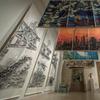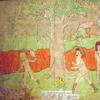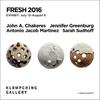Parallel Narratives: The Future of Period and Contemporary Design
- HARTFORD, Connecticut
- /
- October 26, 2018
In celebration of the Wadsworth's partnership with the Wunsch Americana Foundation the museum is hosting a panel to discuss how the past informs and inspires contemporary design. In Hartford, Conn., Parallel Narratives: The Future of Period and Contemporary Design takes place Thursday, November 8 at 7pm and is free and open to the public. Moderated by Decorative Arts Editor, Architectural Digest Mitchell Owens, panelists will explore the fundamental relationships between designs of the past and present. They will share insights on how historic precedents inform their work. What elements from the useable past drive today's tastemakers and designers? What role do museums and collections have, if any, in inspiring contemporary design? Panelists include collectors Eric and Noah Wunsch, designers Thomas Jayne and David Wiseman, and specialists Alexandra Gilbert and Rodman Primack.
All art was once contemporary. Historic American design drew inspiration from distant lands and idealized visions of the past. In the early 20th century, museums played a significant role as designers and artists looked to objects from these collections to create a uniquely modern voice. Fostered in part by a growing enthusiasm for Colonial American decorative arts, and aided by scholarly as well as popular culture publications, historic objects have been a constant touchstone. From the 18th century Chinese-inspired designs of Thomas Chippendale to the Gothic revival of 19th century tastemakers such as Alexander Jackson Davis to the medievalism of the Arts and Crafts, distance - whether physical or temporal - has always informed design. The same holds true today as contemporary artists mine the past and museum collections for ideas and inspiration.
Over the last year, the Wadsworth and Wunsch Americana Foundation have partnered to highlight early American decorative arts. With loans from the Foundation, the Museum has enhanced permanent and rotating gallery spaces. Key objects, such as a rare tea table made by Newport cabinetmaker John Townsend (1733-1809) and an exceptional rococo-style Philadelphia serving table once owned by Chief Justice Benjamin Chew (1722-1810) are on view alongside the Wadsworth's outstanding American art collection, greatly expanding the discussion of historic design.
In conjunction with Parallel Narratives, the Wadsworth will highlight objects that celebrate this important collaboration. The Wunsch Americana Foundation's extraordinary Japanned bureau attributed to Boston artisan Robert Davis (d. 1739) will be exhibited with David Wiseman's exquisite bronze-casted mirror, a contemporary take on eighteenth-century chinoiserie. Wiseman's mirror was inspired by the bureau's exotic birds, buildings, and flora, created through a process called japanning, an English term used to describe work that imitated East Asian lacquerwork. While separated by hundreds of years, Wiseman's contemporary metalwork and the bureau, the only known example of this form attributed to Davis, share a unique dialogue bridging the history of decorative arts and contemporary design.
Debuting in an adjacent gallery is the Wadsworth's most recent American art acquisition - a Rhode Island high chest of drawers contemporary in date to the Wunsch Americana Foundation's japanned bureau. This is high chest's outstanding craftsmanship not only represents the highest expression of early Baroque design, but also signified the wealth of its owner, Samuel Backus (1693-1740) of Norwich, Connecticut, who listed a "Case of Drawers" in his 1741 probate inventory. For almost three hundred years, this high chest descended through the Backus family, journeying between Connecticut and Massachusetts until this year when it joined the collection of the Wadsworth Atheneum.
Panel Discussion Participants
Mitchell Owens is Architectural Digest's Decorative Arts Editor, and has worked for the international design authority since 2010. With a strong interest in global cultures, particularly African and Middle Eastern, Owens travels often and lived in Morocco for several years where he continued to contribute to publications such as the International Herald Tribune. With over 20 years experience in the industry, Owens also worked for the New York Times, Elle Décor, Travel & Leisure, and Departures during his career.
Alexandra Gilbert, vice president, 20th century and contemporary design, Sotheby's Home. With a broad design business background that spans Phillips auction house, Artsy and Surface Media, Alexandra Ashton Gilbert has signed on at online art and design marketplace Viyet, now part of Sotheby's. She works on expanding the dealer, gallery and trade consignor network and manages the merchandising function. Her job and her passion for great design take her all over the world to explore, first hand, the best design shows and architecturally significant houses and buildings.
David Wiseman, designer and head of Wiseman Studio, California. One of the leading American designers of his generation David Wiseman's work draws upon the history of decorative arts and contemporary design to create unique sculptural objects and environmental installations. Wiseman derives inspiration from nature - a blossoming tree branch, a succulent flower, a seedpod, a perching owl - which he uses to create site-specific installations, lighting, furniture, and sculpture. He has created site-specific installations for public institutions, international brands, and private collections. A graduate of the Rhode Island School of Design (RISD), his work is included in the permanent collections of the Los Angeles County Museum of Art, RISD Museum, and the Corning Museum of Glass.
Eric and Noah Wunsch, Co-directors, The Wunsch Americana Foundation,
The Wunsch Americana Foundation is devoted to preservation, education and investment in American antiquities. The foundation has lending, sharing, and gifting relationships with a host of institutions throughout the United States.
Thomas Jayne, principal, Jayne Design Studio, New York City. Thomas Jayne received a Bachelor of Arts from the University of Oregon's School of Architecture and Allied Arts followed by a master's degree from Winterthur museum's program in American material culture and the decorative arts. After he pursued advanced fellowships at the American Wing of the Metropolitan Museum of Art, Historic Deerfield, and the J. Paul Getty Museum before moving on to a position at Christie's estates and appraisal department. Jayne's interest in architecture and the decorative arts eventually led him to a career in interior design. He worked in two of the most influential design studios in America-Parish-Hadley & Associates and Kevin McNamara, inc.-before opening Jayne Design Studio in 1990.
Rodman Primack, founder and executive director, Design Miami. Design Miami is the global forum for design. Each fair brings together the most influential collectors, gallerists, designers, curators and critics from around the world in celebration of design culture and commerce. Occurring alongside the Art Basel fairs in Miami, USA each December and Basel, Switzerland each June, Design Miami/ has become the premier venue for collecting, exhibiting, discussing and creating collectible design.
More info: thewadsworth.org.








100x100_c.jpg)





![Peter Paul Rubens (Flemish, 1577–1640), After Titian (Tiziano Vecelli) (Italian [Venetian], c. 1488–1576), Rape of Europa, 1628–29. Oil on canvas, 71 7/8 x 79 3/8 in. Peter Paul Rubens (Flemish, 1577–1640), After Titian (Tiziano Vecelli) (Italian [Venetian], c. 1488–1576), Rape of Europa, 1628–29. Oil on canvas, 71 7/8 x 79 3/8 in.](/images/c/e2/2e/Jan20_Rape_of_Europa100x100_c.jpg)

